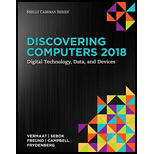
Discovering Computers ©2018: Digital Technology, Data, and Devices
1st Edition
ISBN: 9781337285100
Author: Misty E. Vermaat, Susan L. Sebok, Steven M. Freund, Jennifer T. Campbell, Mark Frydenberg
Publisher: Cengage Learning
expand_more
expand_more
format_list_bulleted
Question
Chapter 3, Problem 6CT
Program Plan Intro
Tablet:
- Tablet is a letter-sized pad that doesn’t include any external devices like mouse, key board and many such.
- It is a portable computer system which can be operated through fingers.
- It includes less weight than a traditional computer system.
- The size of the tablet is less than the mobile phone so, they use stylus or touch screen to interact with tablet.
Expert Solution & Answer
Trending nowThis is a popular solution!

Students have asked these similar questions
Please answer JAVA OOP question below:
Consider the following relationship diagram between the Game and VideoGame data defintion classes.
Game has a constructor that takes in two parameters, title (String) and cost (double). The VideoGame constructor has an additional parameter, genre (String). In Java, efficiently write the constructors needed within the Game class and VideoGame classes.
Hint: Remember to think about the appropriate validation
In a shopping cart, there are various items, which can either belong to the category of household items or electronic items. The following UML diagram illustrates the relationship between items, household items, and electronic items.
//Implementation Class
public class ShoppingCart{
public static void main(String[] args){
final int MAX_ITEM = 50;
Item cart = new Item[MAX_ITEM];
addItem(cart); // populate the item array
printItem(cart);
}
}
Considering that all the data definition classes and the implementation class are complete, which of the following Object-Oriented Programming (OOP) concepts do you need to use in the above context?
i) Polymorphism
ii) Method Overloading
iii) Method Overriding
iv) Dynamic Binding
v) Abstract Class
Explain, using course terminology, how you would use any of the above concepts to model the given scenario.
Answer this JAVA OOP question below:
An Employee has a name, employee ID, and department. An Employee object must be created with all its attributes. The UML diagram is provided below:
- name: String - employeeId: String - department: String
+ Employee(name: String, employeeId: String, department: String) + setName(name: String): void + setEmployeeId(employeeId: String): void + setDepartment(department: String): void + getName(): String + getEmployeeId(): String + getDepartment(): String + toString(): String
A faculty is an Employee with an additional field String field: rank
public class TestImplementation{
public static void main(String[] args){
Employee[] allEmployee = new Employee[100];
// create an employee object with name Tom Evan, employee ID 001 and department IST and store it in allEmployee
// create a faculty object with name Adam Scott, employee ID 002, department IST and rank Professor and store it in allEmployee } }
Chapter 3 Solutions
Discovering Computers ©2018: Digital Technology, Data, and Devices
Ch. 3 - Prob. 1SGCh. 3 - Prob. 2SGCh. 3 - Prob. 3SGCh. 3 - Prob. 4SGCh. 3 - Prob. 5SGCh. 3 - Prob. 6SGCh. 3 - Prob. 7SGCh. 3 - Prob. 8SGCh. 3 - Prob. 9SGCh. 3 - Prob. 10SG
Ch. 3 - Prob. 11SGCh. 3 - Prob. 12SGCh. 3 - Prob. 13SGCh. 3 - Prob. 14SGCh. 3 - Prob. 15SGCh. 3 - Prob. 16SGCh. 3 - Prob. 17SGCh. 3 - Prob. 18SGCh. 3 - Prob. 19SGCh. 3 - Prob. 20SGCh. 3 - Prob. 21SGCh. 3 - Prob. 22SGCh. 3 - Prob. 23SGCh. 3 - Prob. 24SGCh. 3 - Prob. 25SGCh. 3 - Prob. 26SGCh. 3 - Prob. 27SGCh. 3 - Prob. 28SGCh. 3 - Prob. 29SGCh. 3 - Prob. 30SGCh. 3 - Prob. 31SGCh. 3 - Prob. 32SGCh. 3 - Prob. 33SGCh. 3 - Prob. 34SGCh. 3 - Prob. 35SGCh. 3 - Prob. 36SGCh. 3 - Prob. 37SGCh. 3 - Prob. 38SGCh. 3 - Prob. 39SGCh. 3 - Prob. 40SGCh. 3 - Prob. 41SGCh. 3 - Prob. 42SGCh. 3 - Prob. 43SGCh. 3 - Prob. 44SGCh. 3 - Prob. 45SGCh. 3 - Prob. 46SGCh. 3 - Prob. 47SGCh. 3 - Prob. 48SGCh. 3 - Prob. 49SGCh. 3 - Prob. 1TFCh. 3 - Prob. 2TFCh. 3 - Prob. 3TFCh. 3 - Prob. 4TFCh. 3 - Prob. 5TFCh. 3 - Prob. 6TFCh. 3 - Prob. 7TFCh. 3 - Prob. 8TFCh. 3 - Prob. 9TFCh. 3 - Prob. 10TFCh. 3 - Prob. 11TFCh. 3 - Prob. 12TFCh. 3 - Prob. 1MCCh. 3 - Prob. 2MCCh. 3 - Prob. 3MCCh. 3 - Prob. 4MCCh. 3 - Prob. 5MCCh. 3 - Prob. 6MCCh. 3 - Prob. 7MCCh. 3 - Prob. 8MCCh. 3 - Prob. 1MCh. 3 - Prob. 2MCh. 3 - Prob. 3MCh. 3 - Prob. 4MCh. 3 - Prob. 5MCh. 3 - Prob. 6MCh. 3 - Prob. 7MCh. 3 - Prob. 8MCh. 3 - Prob. 9MCh. 3 - Prob. 10MCh. 3 - Prob. 2CTCh. 3 - Prob. 3CTCh. 3 - Prob. 4CTCh. 3 - Prob. 5CTCh. 3 - Prob. 6CTCh. 3 - Prob. 7CTCh. 3 - Prob. 8CTCh. 3 - Prob. 9CTCh. 3 - Prob. 10CTCh. 3 - Prob. 11CTCh. 3 - Prob. 12CTCh. 3 - Prob. 13CTCh. 3 - Prob. 14CTCh. 3 - Prob. 15CTCh. 3 - Prob. 16CTCh. 3 - Prob. 17CTCh. 3 - Prob. 18CTCh. 3 - Prob. 19CTCh. 3 - Prob. 20CTCh. 3 - Prob. 21CTCh. 3 - Prob. 22CTCh. 3 - Prob. 23CTCh. 3 - Prob. 24CTCh. 3 - Prob. 25CTCh. 3 - Prob. 26CTCh. 3 - Prob. 27CTCh. 3 - Prob. 28CTCh. 3 - Prob. 29CTCh. 3 - Prob. 30CTCh. 3 - Prob. 1PSCh. 3 - Prob. 2PSCh. 3 - Prob. 3PSCh. 3 - Prob. 4PSCh. 3 - Prob. 5PSCh. 3 - Prob. 6PSCh. 3 - Prob. 7PSCh. 3 - Prob. 8PSCh. 3 - Prob. 9PSCh. 3 - Prob. 10PSCh. 3 - Prob. 11PSCh. 3 - Prob. 1.1ECh. 3 - Prob. 1.2ECh. 3 - Prob. 2.1ECh. 3 - Prob. 2.2ECh. 3 - Prob. 2.3ECh. 3 - Prob. 3.1ECh. 3 - Prob. 3.2ECh. 3 - Prob. 3.3ECh. 3 - Prob. 4.1ECh. 3 - Prob. 4.2ECh. 3 - Prob. 4.3ECh. 3 - Prob. 5.1ECh. 3 - Prob. 5.2ECh. 3 - Prob. 5.3ECh. 3 - Prob. 1IRCh. 3 - Prob. 2IRCh. 3 - Prob. 3IRCh. 3 - Prob. 4IRCh. 3 - Prob. 1CTQCh. 3 - Prob. 2CTQCh. 3 - Prob. 3CTQCh. 3 - Prob. 4CTQ
Knowledge Booster
Similar questions
- Please answer this JAVA OOP question that is given below: An Employee has a name, employee ID, and department. An Employee object must be created with all its attributes. The UML diagram is provided below: - name: String - employeeId: String - department: String + Employee(name: String, employeeId: String, department: String) + setName(name: String): void + setEmployeeId(employeeId: String): void + setDepartment(department: String): void + getName(): String + getEmployeeId(): String + getDepartment(): String + toString(): String A faculty is an Employee with an additional field String field: rank Assuming the Employee class is fully implemented, define a Professor class in Java with the following: A toString() method that includes both the inherited attributes and the specializationarrow_forwardPlease answer JAVA OOP question below: An Employee has a name, employee ID, and department. An Employee object must be created with all its attributes. The UML diagram is provided below: - name: String - employeeId: String - department: String + Employee(name: String, employeeId: String, department: String) + setName(name: String): void + setEmployeeId(employeeId: String): void + setDepartment(department: String): void + getName(): String + getEmployeeId(): String + getDepartment(): String + toString(): String A faculty is an Employee with an additional field String field: rank Assuming the Employee class is fully implemented, define a Professor class in Java with the following: Instance variable(s) A Constructorarrow_forwardDevelop a C++ program that execute the operation as stated by TM for addition of two binary numbers (see attached image). Your code should receive two binary numbers and output the resulting sum (also in binary). Make sure your code mimics the TM operations (dealing with the binary numbers as a string of characters 1 and 0, and following the logic to increase the first number and decreasing the second one. Try your TM for the following examples: 1101 and 101, resulting 10010; and 1101 and 11, resulting 10000.arrow_forward
- I need to define and discuss the uses of one monitoring or troubleshooting tool in Windows Server 2019. thank youarrow_forwardI would likr toget help with the following concepts: - Windows Server features - Windows Server versus Windows 10 used as a client-server networkarrow_forwardI need to define and discuss the uses of one monitoring or troubleshooting tool in Windows Server 2019. thank youarrow_forward
arrow_back_ios
SEE MORE QUESTIONS
arrow_forward_ios
Recommended textbooks for you
 Enhanced Discovering Computers 2017 (Shelly Cashm...Computer ScienceISBN:9781305657458Author:Misty E. Vermaat, Susan L. Sebok, Steven M. Freund, Mark Frydenberg, Jennifer T. CampbellPublisher:Cengage Learning
Enhanced Discovering Computers 2017 (Shelly Cashm...Computer ScienceISBN:9781305657458Author:Misty E. Vermaat, Susan L. Sebok, Steven M. Freund, Mark Frydenberg, Jennifer T. CampbellPublisher:Cengage Learning Fundamentals of Information SystemsComputer ScienceISBN:9781305082168Author:Ralph Stair, George ReynoldsPublisher:Cengage Learning
Fundamentals of Information SystemsComputer ScienceISBN:9781305082168Author:Ralph Stair, George ReynoldsPublisher:Cengage Learning Systems ArchitectureComputer ScienceISBN:9781305080195Author:Stephen D. BurdPublisher:Cengage Learning
Systems ArchitectureComputer ScienceISBN:9781305080195Author:Stephen D. BurdPublisher:Cengage Learning C++ Programming: From Problem Analysis to Program...Computer ScienceISBN:9781337102087Author:D. S. MalikPublisher:Cengage Learning
C++ Programming: From Problem Analysis to Program...Computer ScienceISBN:9781337102087Author:D. S. MalikPublisher:Cengage Learning A+ Guide To It Technical SupportComputer ScienceISBN:9780357108291Author:ANDREWS, Jean.Publisher:Cengage,
A+ Guide To It Technical SupportComputer ScienceISBN:9780357108291Author:ANDREWS, Jean.Publisher:Cengage,

Enhanced Discovering Computers 2017 (Shelly Cashm...
Computer Science
ISBN:9781305657458
Author:Misty E. Vermaat, Susan L. Sebok, Steven M. Freund, Mark Frydenberg, Jennifer T. Campbell
Publisher:Cengage Learning


Fundamentals of Information Systems
Computer Science
ISBN:9781305082168
Author:Ralph Stair, George Reynolds
Publisher:Cengage Learning

Systems Architecture
Computer Science
ISBN:9781305080195
Author:Stephen D. Burd
Publisher:Cengage Learning

C++ Programming: From Problem Analysis to Program...
Computer Science
ISBN:9781337102087
Author:D. S. Malik
Publisher:Cengage Learning

A+ Guide To It Technical Support
Computer Science
ISBN:9780357108291
Author:ANDREWS, Jean.
Publisher:Cengage,